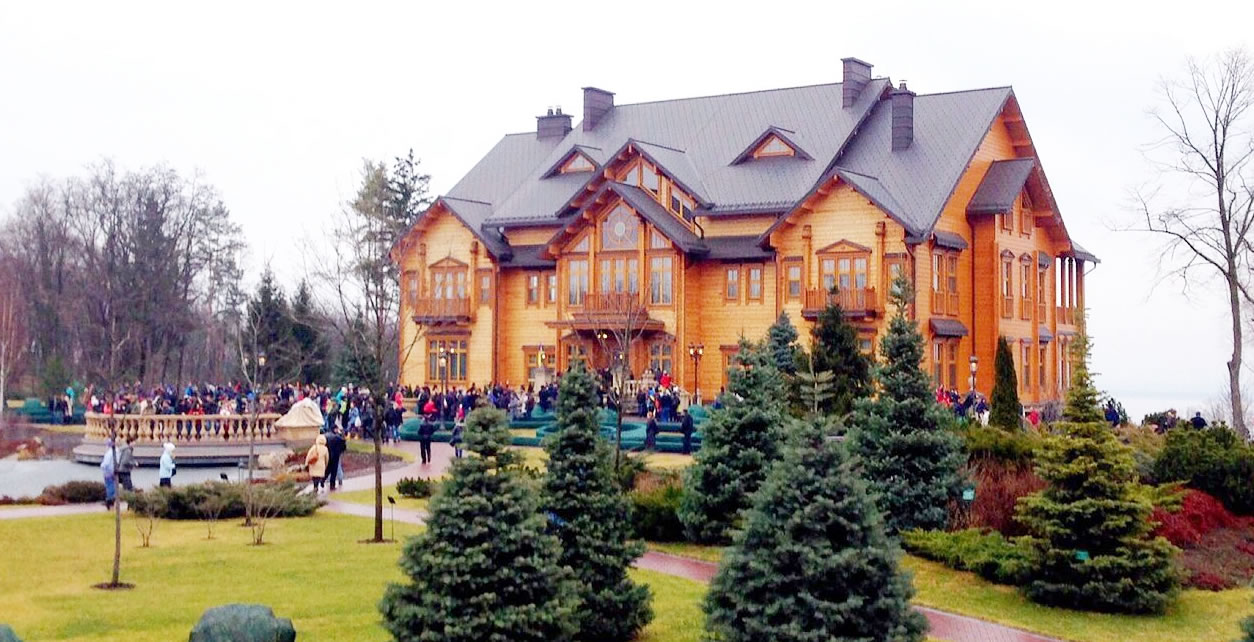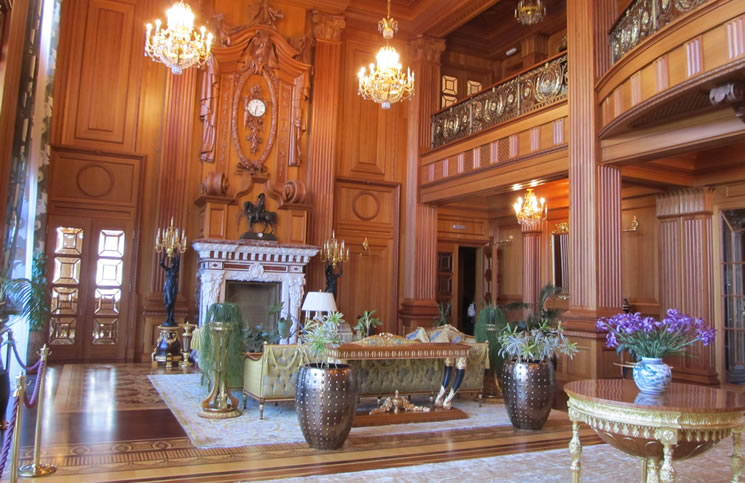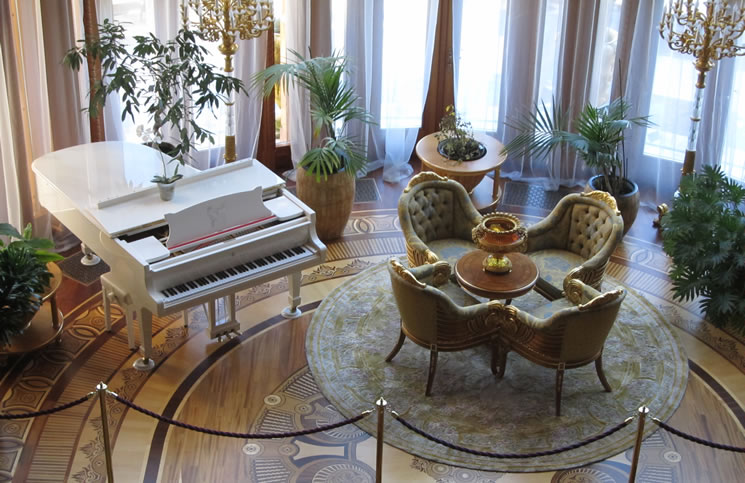Secret home of former Ukraine president now a tourist attraction
Diane Slawych
REM

Officially the home is called Mezhyhirya, but locals sometimes refer to it as the ?house of corruption?.

?We didn?t allow people to steal or crush everything, that?s why a lot was preserved here,? the Ukrainian caretaker told our translator.

The piano in the living room. Note the inlaid wood floor.
The newest tourist attraction in Ukraine’s capital Kyiv is the secret home of the country’s former president, Viktor Yanukovych.
Officially it’s called Mezhyhirya, but locals sometimes refer to it as the “house of corruption” because they cannot fathom how a man whose previous government salary had never exceeded $2,000 a month could afford to purchase 137 hectares of prime real estate and build a five-storey mansion valued at $100 million.
“When we are inside, you will see crystal chandeliers and Lalique tables,” says local guide Diana Borysenko on the drive to the property. “If this is what he left behind, imagine what he took with him.”
Yanukovych was ousted in the Euromaidan Revolution in 2014 after citizens blamed him for everything from lavish spending, including six million Euros of public money on a helicopter for his personal use, to the deaths of protesters.
While in office Yanukovych gave the impression he led a modest life, occasionally inviting journalists to a small home that he claimed was his only residence. No one knew he took over the Mezhyhirya estate.
“From Google Maps, it was impossible to see what was going on there because the signal was blocked…and he had security guards around the house, so he was super, super protected,” says Borysenko.
What he created has been described as a city within a city. Mezhyhirya was largely self-sufficient. The ex-president kept farm animals for food, while fruits and vegetables were grown in greenhouses that mimicked 20 different climatic zones. He also had his own medical centre, a gas station and helicopter pad.
No expense was spared when it came to recreation. There was an 18-hole golf course, a rare breed dog kennel, an underground shooting range, a riding club with an indoor exercise space, stables for the horses that were apparently gifts from the presidents of Poland and Turkmenistan, a tennis court, spa facilities, a zoo and an impressive collection of antique vehicles.
The property has a long history. “It’s one of the sacred places for us because one of the first Christian Orthodox churches was built here in the 10th century and then there was a monastery for a couple of centuries,” says Borysenko.
“But when the Soviets came, it was a residence of communist officials… and when Ukraine gained independence, they started sharing the territory and Yanukovych was the one who really wanted that spot.”
When he secured it for himself, Yanukovych hired the Finnish company Honka, a world leader in the construction of wooden buildings, to erect a five-storey mansion facing the Dniper River and fronted by a landscaped garden with decorative plantings and fountains.
A general admission ticket allows visitors to wander the grounds, where deer and other animals roam freely, but seeing the inside of the mansion requires an appointment with a man named Petrov, one of the protesters from the Maidan, who now acts as the caretaker and guide.
Draped in a red and black flag, he welcomes us through a side entrance. As we put protective slip covers over our shoes as instructed, I look up and realize we’re in a bowling alley!
From here we are ushered through a quick succession of rooms – the winter garden (with taxidermy lions); the spa facility (including a hyperbaric chamber, a hammam and even a salt therapy room); a movie room, a gym with a boxing ring and brand-new exercise equipment.
A long underground corridor, decorated with paintings, leads to the main house. When we’re shown the elaborate indoor air purification room, I suddenly become aware of the excellent air quality. The specialized equipment, we are told, creates a microclimate around the house and helps preserve the home’s precious wood – including the stunning inlaid wood floors.
On the second level, which has a beautiful private church room, Petrov occasionally points out the odd juxtaposition of high-end features such as imported marble, mosaics or Italian crystal alongside cheap vases, or, in one case, a $10 wall clock.
Enlivening the space is the sound of cheerful bird song – emanating from canaries in various cages on the main floors. Two near identical bedrooms – one for Yanukovych and another for his mistress, both have ensuite bathrooms, walk-in closets and balconies offering views over the garden.
Yanukovych’s wife remained in eastern Ukraine and never appeared with him officially, while he took up residence with his mistress, a woman who previously worked at Mezhyhirya as a waitress. She would test his food after he became paranoid about being poisoned.
“You realize the way he organized everything in the house he was planning to live there forever,” says Borysenko. “But he lived there for only two years and then he had to run away.”
As we walked from room to room, the guide occasionally points out little stickers above the doorways verifying the home had been officially blessed. While it didn’t help its occupants, it may have conferred a measure of safety on the house itself, especially when you consider how the homes of other recently deposed world leaders (think Libya and Iraq), were ransacked by angry citizens.
“We didn’t allow people to steal or crush everything, that’s why a lot was preserved here,” the Ukrainian caretaker told our translator. While he acknowledges “little things may have been stolen,” he adds that a lot of valuables were saved.
Some are now in Ukrainian art museums in Kyiv, some were put in storage for safe keeping and others such as sculptures, a rare piano and an elegant and rare music box, remain in the mansion.
Outside, where people explore the grounds on foot or by bicycle (which you can rent here), we hop on an electric-powered vehicle to get a sense of the size of the well-manicured property.
Along the smoothly paved tree-lined road, our guide points out the yacht club; a large boat that functioned as a restaurant; and Yanukovych’s personal chemical lab where food was checked to ensure it wasn’t poisoned. There were buildings for security guards and a canteen and gym for workers. It took a staff of 2,000 to keep everything running.
Volunteers looking after the property, which had been a national sanctuary, hope it will be nationalized. But Yanukovych was thinking ahead, our guide explains. “While in power as a deputy before becoming president, he registered the property deeds to third parties.” The matter has become difficult to unravel and is mired in the courts. “If you come back one day, it could be closed,” laments Borysenko, referring to what may happen if the issue is not resolved in the national interest.
As for Yanukovych’s current whereabouts? In February, he was convicted of treason by a Ukrainian court and sentenced to 13 years in prison. But he did not appear at his trial and now reportedly lives in Russia.
“During the night he put valuable things in the trucks and jumped into the helicopter (the $6-million Euros one) and flew away. It was quite easy for him,” says our guide. (Meanwhile, tourists who want to see the house and don’t have their own private aircraft can at least take advantage of direct flights between Toronto and Kyiv twice a week with Ukraine International Airlines.)
Judging by some of the souvenirs outside the gate to the property, some locals envision another, more appropriate place that their former president could spend his days. One fridge magnet shows Yanukovych behind bars in a jail cell with the caption: “Finally I’m home.”
© 2019 REM Real Estate Magazine

